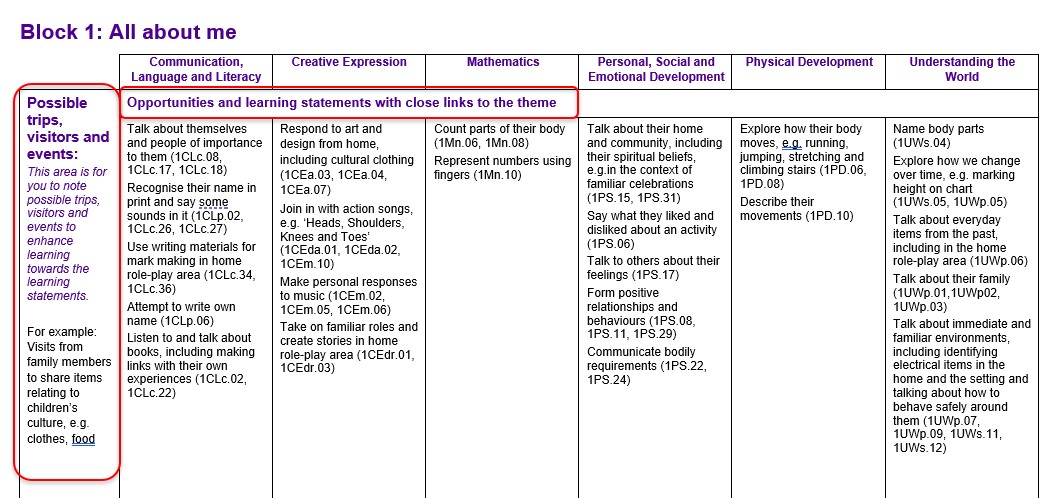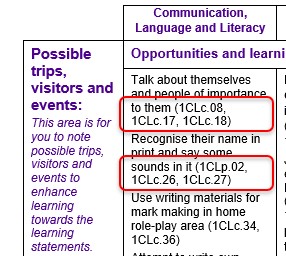Planning
Long-term planning
The steps below will help to inform your high-level thinking for the whole year. The examples provided are based on the template below. It assumes that all your children will be with you across the whole year:
Example EY1 long-term plan Remember: Long-term planning happens before you know your children well. It needs to be flexible so that, as you get to know your children better, you can provide contexts for learning that match their interests and needs.Step 1: Plan your general continuous provision for the year
Note the continuous provision areas you will provide across the year and create a list of the extra resources you want to source for those areas.
Note: The term ‘continuous provision’ means the resources and areas in your learning environment that children can choose from and explore freely across the year.
Step 2: Decide on your themes for the year
Themes that span several weeks can be engaging contexts for teaching and learning in early years. Using themes:
- supports a holistic approach to learning and helps children to make connections between different curriculum areas
- is motivating for children, especially when your themes match their interests
- helps children to relate their learning to their experiences beyond your setting.
The example long-term plans below are based on the following themes. Each theme relates to a five-week block of teaching and learning:
| EY1 All about me Senses Food Animals People who help us Transport |
EY2 Underwater worlds Superheroes The alphabet Buildings and places Once upon a time Growing |
EY3 Bugs My country and traditions Space and planet Earth Caring for our planet Then and now Fantasy and the future |
|---|
Example EY1 long-term plan Example EY2 long-term plan Example EY3 long-term plan You can use these long-term plans as a starting point for your own planning. Or you might decide to choose some of your own themes instead.
Note: The level of detail in the example long-term plans aims to demonstrate the thinking behind the planning. Your own long-term plan might be less detailed.
Using some of your own themes
When choosing your own themes, ensure that they:
- are suitable as the context for several weeks of teaching and learning
- provide effective opportunities for developing learning towards all curriculum areas
- are meaningful to children
- build on children’s own interests
- are unique to each year for maximum motivation for children across their early years experience
- are planned for an appropriate time of the year (e.g. when weather will allow for key outside activities, or to coincide with a key community or cultural event).
Step 3: Note teaching and learning opportunities with close links to your themes
Once you have decided on your themes and how long you will spend on each theme, start noting:
- teaching and learning opportunities for different curriculum areas that relate closely to your themes
- possible trips, visitors and events that will enhance learning.
At this stage, you can just outline the intended concepts and skills, rather than recording detailed activities. You can refine your high-level thinking during your medium-term and short-term planning.

Step 4: Check alignment with the curriculum
Reference the learning statement(s) from the Cambridge Early Years Curriculum that each of your teaching and learning opportunities develops.

Refine your thinking: add, remove and reorder your teaching and learning opportunities by:
- deciding which opportunities will most effectively develop learning towards the learning statements
- deciding which opportunities will most effectively develop connections between learning in different curriculum areas
- checking that there is progression of learning across the year.
Use the curriculum document as a checklist to identify:
- which learning statements you can develop fully using your themed teaching and learning opportunities
- which learning statements you will develop or consolidate in a less themed way.

Step 6: Note teaching and learning opportunities that are less closely related to your themes
Based on your findings from Step 5, note curriculum learning statements that need more development and consolidation than is possible just through themed activities. Ensure that all the curriculum learning statements will be fully developed across the year and that children’s learning will progress smoothly.

The example long-term plans already include:
- Mathematics learning statements that reflect the activities provided in the Cambridge Early Years Teacher’s Book
- suggestions for where you might develop phonics, handwriting and spelling learning statements using your systematic phonics and handwriting schemes
- some learning statements that are best developed, or further developed, in a less themed way.
You will need to decide which other learning statements are most effectively developed or consolidated in a less themed way for your children.
Step 7: Identify extra resourcesNote any extra resources you want to source to support teaching and learning for each themed block. This includes resources that you will add to continuous provision areas temporarily to enhance the opportunities they provide for children’s learning towards the block’s learning statements.
